Prime
Update on KCCA road project

AUTHOR: Simon kasyate. PHOTO/HANDOUT
What you need to know:
- There are project neighbours who are hesitant to allow for auxiliary works on their premises.
If you have passed through roads such as Salaama Road, Sir Apollo Kagwa, Industrial Area roads, you wouldn’t blame anyone that receives you with a ‘Welcome from Hell’ placard! The ‘more-hell-than-your-neighbourhood roads contests’ have been a staple on social media; getting worse every time after it rains.
Citizens were promised that all this shall start to end in February as Kampala Capital City Authority kicks off the Kampala City Roads Rehabilitation Project (KCRRP) that entails improvement of 100km of roads, 123km of non-motorised traffic facilities, and provision of street lighting etc.
Minutes after the clock struck midnight on February 1, Twitter went abuzz with some tweeting “It’s February, any sign of road works in your hood?” That goes a long way to describe the desperation of all of us in the city to have roads that are car worthy. Not even Valentine’s Day or St Janani Luwum Day served to pepper down the growing demands to see earth movers rumbling through, breaking ground and things moving to show full-scale rehabilitation of our roads.
Instead, citizens are being told of things like ‘forward maintenance’ and contractors ‘mobilising’ -which is indeed the truth in regards to the latest update on the progress of this project, but which does not make sense for citizens who have for years endured the shock and awe of menacingly degraded roads, disintegrating their motor vehicles and some their limbs. The devil is in the details, they say. Today, I wish to stripe these terms ‘Forward maintenance’ and ‘mobilisation’ by the contractors. Perhaps then can the progress on the rehabilitation of our city roads start to make sense.
Most if not all the roads to be rehabilitated are in dire state. As such, KCCA agreed with the contractors that before they embark on the full-scale ripping up and reconstruction of the roads, they patch up the craters and gullies in those sections where one needs amphibian type of motor vehicles to navigate.
Most contractors have now erected project signboards. When a project signboard is up; that signifies a start of works in earnest. The forward maintenance has been welcomed by some, albeit with tongue in cheek. “So patching potholes means filling craters with loam soil and proceeding to kill us with dust or mud when it rains?” among others. One, every road has soil as part of the composition; reinforced ‘soil’ (marram with lime) is poured into the potholes, compacted and let to set before a layer of tarmac is applied. Road building follows an elaborate process and procedure which is followed without compromise, lest one compromises on the quality desired.
This project covers five lots, four of which have so far been successfully contracted after a lengthy transparent international bidding and meticulous procurement process. The parameters for these best evaluated bidders was on many tenets including and not limited to least price. So these contractors are currently onboarding staff, majority of whom will be locals qualified in various disciplines. The contractors have to bring in their equipment, most of which are sourced from abroad.
The contractors are acquiring space for offices, material yards etc. Finding this space, and negotiating rent or lease arrangements takes time.
The contractors are on the ground sourcing materials for approval. It is an industry practice for such infrastructure projects that materials are tested by an accredited laboratory for quality assurance.
The sourcing of the materials includes negotiations and signing agreements with suppliers among others. Even after contractors have secured sources for materials, they proceed to scout for alternative sources as ‘an insurance’ against any ‘what if’. Take the scenario where they have signed a supply contract for cement from one entity and in the middle of works, the supplier faces challenges and is unable to meet their quota.
As they tussle out contractual obligations, litigation and what not, the project should be able to proceed with materials from alternative sources. Almost all these roads will be widened. In their current size, there are utility infrastructure such as water pipes, electricity lines, data and telecom lines and other facilities that will be relocated. Discussions with the utility owners on the modus of relocation is a painstaking engagement.
The contractors often will prefer to use the subcontractors of these utility companies to do the relocation-that could mean negotiations with these subcontractors.
While many citizens have benevolently granted their land to this project to allow for right of way, there are some belligerent ones who continue to make prohibitive demands and as such straining the full acquisition of ‘right of way’ for the project. There are project neighbours who are hesitant to allow for auxiliary works on their premises. To these, who are acting within their right because of their ownership to the adjoining land, engagements are underway.
When we said the contractors shall start works with mobilisation in February, KCCA meant all the above and more. Sadly, much of what’s within the ambit of mobilisation is activities that are not within the glare of eyesight.
Simon P Kasyate is the Kampala Capital City Authority (KCCA) spokesperson.




